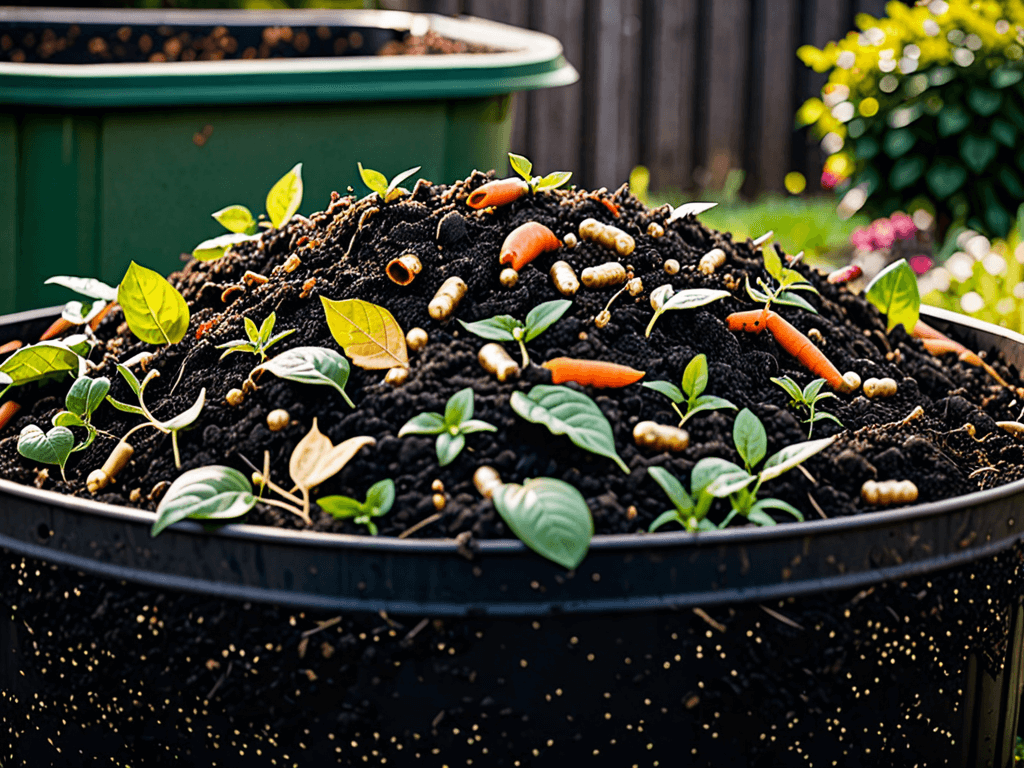Urban composting is a revolutionary approach to waste management that turns kitchen scraps into nutrient-rich soil.
As city living becomes more conscious of its environmental impact, urban composting offers a sustainable solution to managing food waste.
This guide will walk you through the essentials of starting your own compost system in a limited urban space, ensuring your contribution towards a greener planet.
Whether you’re using a small balcony or even just a corner in your kitchen, discover how urban composting can transform waste into a valuable resource for your garden.
What is Urban Composting?
Urban composting refers to the process of decomposing organic waste in densely populated areas to produce nutrient-rich compost. This method promotes sustainability by reducing the amount of waste sent to landfills and decreasing greenhouse gas emissions.
In city settings, where space is limited, urban composting can be done using compact and efficient systems like worm bins or bokashi composting. These approaches are specifically designed to fit small spaces such as apartments and balconies, allowing residents to easily participate in composting initiatives.
Additionally, urban composting not only benefits the environment, but also gives city dwellers access to fertile soil for urban gardening projects. By turning household waste into compost, individuals can foster greener living environments and support local ecosystems even in urban landscapes.
Benefits of Urban Composting
Urban composting provides numerous environmental benefits. It helps reduce the volume of waste sent to landfills, thus lowering methane emissions and aiding in climate change mitigation.
Composting also improves soil health by returning essential nutrients to the earth, enhancing plant growth and reducing the need for chemical fertilizers.
Moreover, urban composting saves money as it decreases waste disposal costs. Residents can turn kitchen scraps into a valuable resource, reducing the need to buy expensive soil conditioners.
This sustainable practice encourages community involvement and fosters environmental awareness among urban populations.
On a larger scale, composting initiatives can transform urban areas into greener spaces, improving air quality and creating habitats for wildlife.
These benefits illustrate why embracing urban composting can lead to a healthier and more sustainable urban environment.
How to Start Urban Composting at Home
Starting urban composting at home is a simple process that begins with choosing the right spot for your compost bin. Location is key as you want an area with good airflow but not directly exposed to harsh weather conditions.
Next, select a compost bin that matches your living space and lifestyle. Options range from compact worm bins to larger tumbler bins suitable for patios. Once set up, begin by adding organic materials such as fruit peels, vegetable scraps, and coffee grounds. Avoid dairy or meat products as they can attract pests.
Balance is essential in composting. A good mix of green materials (nitrogen-rich like vegetable scraps) and brown materials (carbon-rich like dry leaves) will ensure a healthy compost. Regularly turning the pile or rotating the bin will help speed up the decomposition process.
With patience and care, within a few months, you’ll produce rich compost that can be used to nourish your plants or shared with community gardens, promoting sustainability right from your home.
Essential Tools for Urban Composting
Having the right tools can make urban composting both efficient and convenient. The first essential tool is a compost bin. Depending on your space, choose a compact model like a kitchen caddy or a larger outdoor tumbler. These are designed to fit tight living areas while keeping odors contained.
A compost aerator or hand trowel can be useful for mixing and turning the compost. This helps in speeding up the decomposition process. A good pair of gloves will protect your hands when handling organic waste and turning the compost.
Additionally, a spray bottle of water helps maintain the right moisture level, which is crucial for proper decomposition. A moisture meter can also be helpful to ensure you’re maintaining the right balance between wet and dry materials.
Lastly, a supply of starter compost or compost activator can kickstart the microbial activity in your bin, leading to faster compost production. By equipping yourself with these tools, you’ll be well on your way to successful urban composting.
Choosing the Right Compost Bin
Choosing the right compost bin is essential for effective urban composting. The first step is to assess your space. For small indoor spaces, a kitchen caddy or countertop compost bin is ideal, allowing you to collect scraps without odor. These bins are typically compact and designed for easy cleaning.
If you have outdoor space, consider a tumbler compost bin. Tumblers make turning the compost easy, which is necessary for aeration and quick decomposition. For those with a bit more space, wooden or plastic compost bins can store larger quantities of compostable materials.
Another key factor is the composting method you prefer. Worm compost bins, or vermicomposting, are great for indoors and involve using worms to break down organic matter. This method is efficient and produces rich, nutrient-dense compost.
Ultimately, the right choice depends on your available space, budget, and commitment level. Remember, whatever bin you choose, it should be durable and have good ventilation to allow for proper decomposition.
The Do’s and Don’ts of Urban Composting
Understanding the do’s and don’ts of urban composting can lead to a more successful composting experience. Do mix equal parts of green and brown materials. This balance ensures proper decomposition and reduces odor. Keep your compost moist but not soaking, as a damp environment helps microbes break down waste.
Another do is to chop larger scraps into smaller pieces. This increases the surface area and speeds up decomposition. Regularly turning your compost pile is essential for aeration, which is necessary for aerobic bacteria to thrive.
On the other hand, don’t add dairy, meat, or oils to your compost. These items can attract pests and create unpleasant smells. Avoid adding diseased plants since this can transfer pathogens to your new compost.
Finally, don’t overlook temperature adjustments. In colder months, you might need to insulate your compost to maintain a consistent temperature that encourages the composting process.
Overcoming Common Urban Composting Challenges
Urban composting often presents challenges such as limited space, pest management, and maintaining odor control.
To tackle these, start by selecting a compost bin that fits your area.
Compact or stackable bins are ideal for small spaces and can help keep your compost organized.
Pests can be a problem, but easily avoid them by not including meat or dairy products in your compost.
Ensure your bin is sealed properly and consider using pest deterrents like diatomaceous earth if necessary.
Odor can also become an issue when composting indoors.
To combat this, balance your green and brown materials correctly and ensure proper aeration by turning the compost regularly.
Adding a layer of carbon-rich brown materials such as dried leaves or shredded paper can help absorb moisture and reduce smells.
Another common challenge is achieving the right moisture level.
Compost should feel like a damp sponge.
If it’s too dry, sprinkle water, and if too wet, add more brown materials to absorb excess moisture.
Urban Composting Success Stories
Urban composting is transforming city landscapes and community initiatives into thriving ecological projects. In New York, for example, neighborhood composting programs have significantly reduced landfill waste. Local residents actively participate by contributing their organic waste, which is then used to enrich city gardens.
Los Angeles has embraced urban composting through community gardens, where people get hands-on experience turning food scraps into fertile soil. These gardens not only beautify the city but also educate people about sustainable living and food production.
In Chicago, composting has been integrated into schools, teaching students the importance of waste reduction. Children participate in collecting lunch scraps and monitoring compost bins, fostering a sense of responsibility towards the environment.
These success stories highlight how urban composting can unite communities, enhance green spaces, and promote environmental awareness. From neighborhood programs to schools, urban composting is proving that small efforts can lead to significant environmental benefits.
Urban Composting: A Path to Sustainable Living
Urban composting offers city dwellers a practical solution to reduce waste and enhance environmental sustainability.
By transforming kitchen scraps into valuable compost, individuals can contribute to healthier city ecosystems and support urban agriculture.
Adopting composting practices not only reduces landfill dependency but also enriches the soil of urban gardens, promoting greener and more vibrant communities.
Success stories from various urban areas highlight how simple adjustments in waste management can lead to significant ecological improvements.
Embracing urban composting is a step towards a more sustainable future, fostering community involvement and environmental responsibility.
FAQ – Frequently Asked Questions about Urban Composting
What materials can I compost at home?
You can compost fruit and vegetable scraps, coffee grounds, eggshells, and yard waste like leaves and grass clippings.
How long does composting take?
Composting can take anywhere from a few weeks to several months, depending on factors like temperature, moisture, and the materials used.
Is composting indoors possible?
Yes, indoor composting is possible using methods like vermicomposting with worms or using specialized indoor compost bins.
What should I avoid putting in my compost bin?
Avoid composting meat, dairy, oils, diseased plants, and pet waste as they can cause odor, attract pests, or spread disease.
How can I prevent odors in my compost?
Maintain a balanced mix of green and brown materials, ensure proper aeration, and avoid adding problematic items like meat or dairy.
Why is my compost not breaking down?
This could be due to a lack of moisture, insufficient aeration, or an imbalance of green and brown materials.


